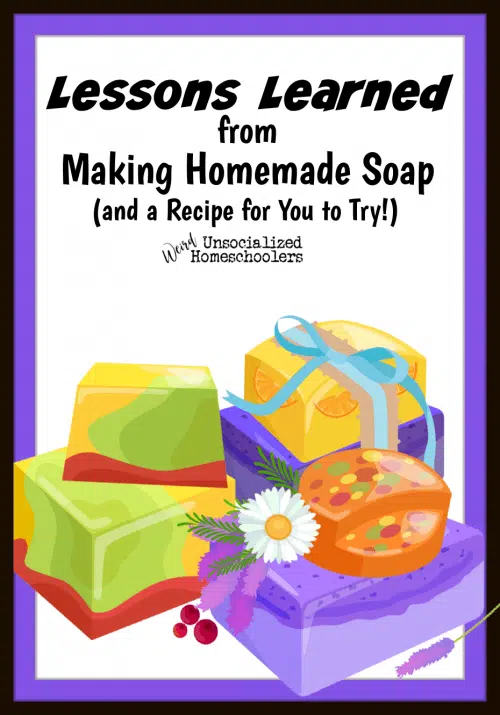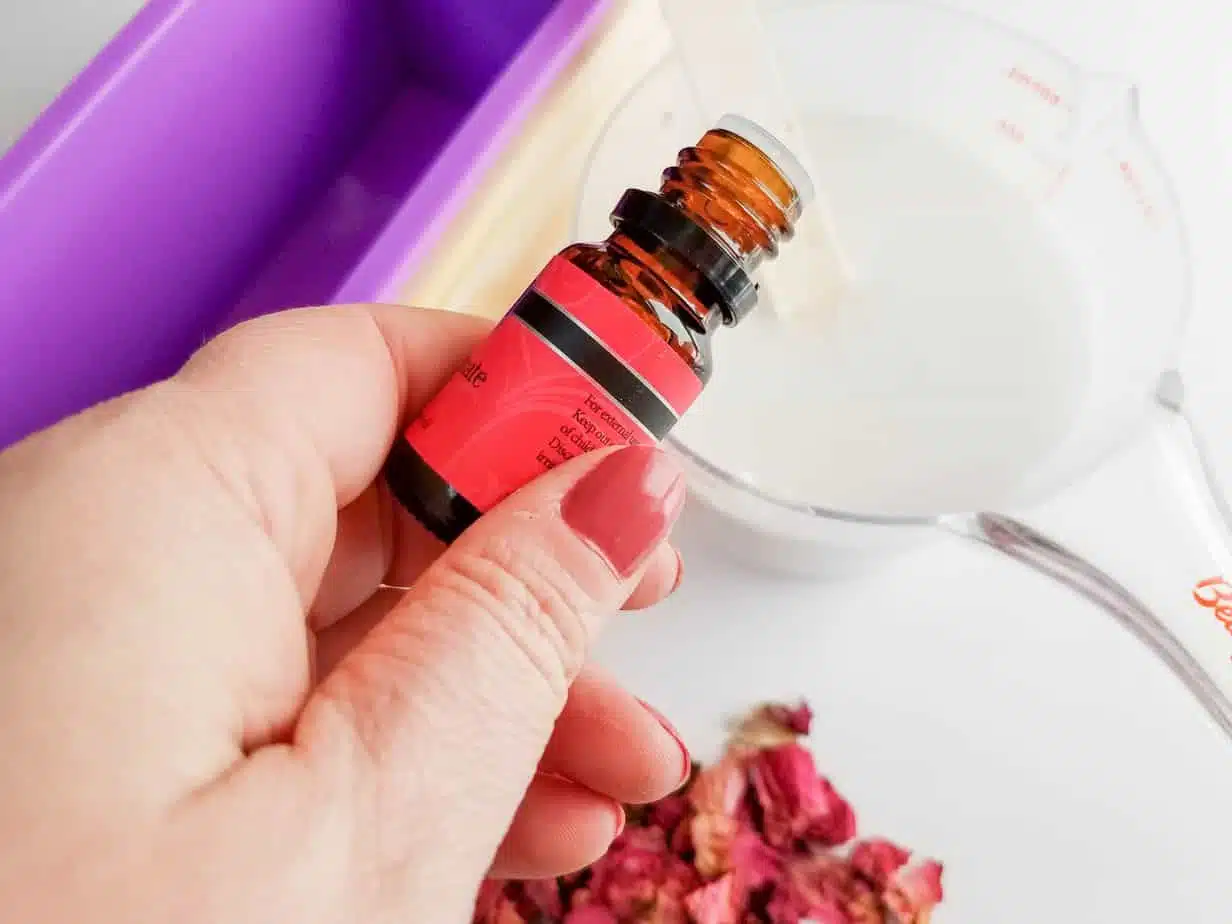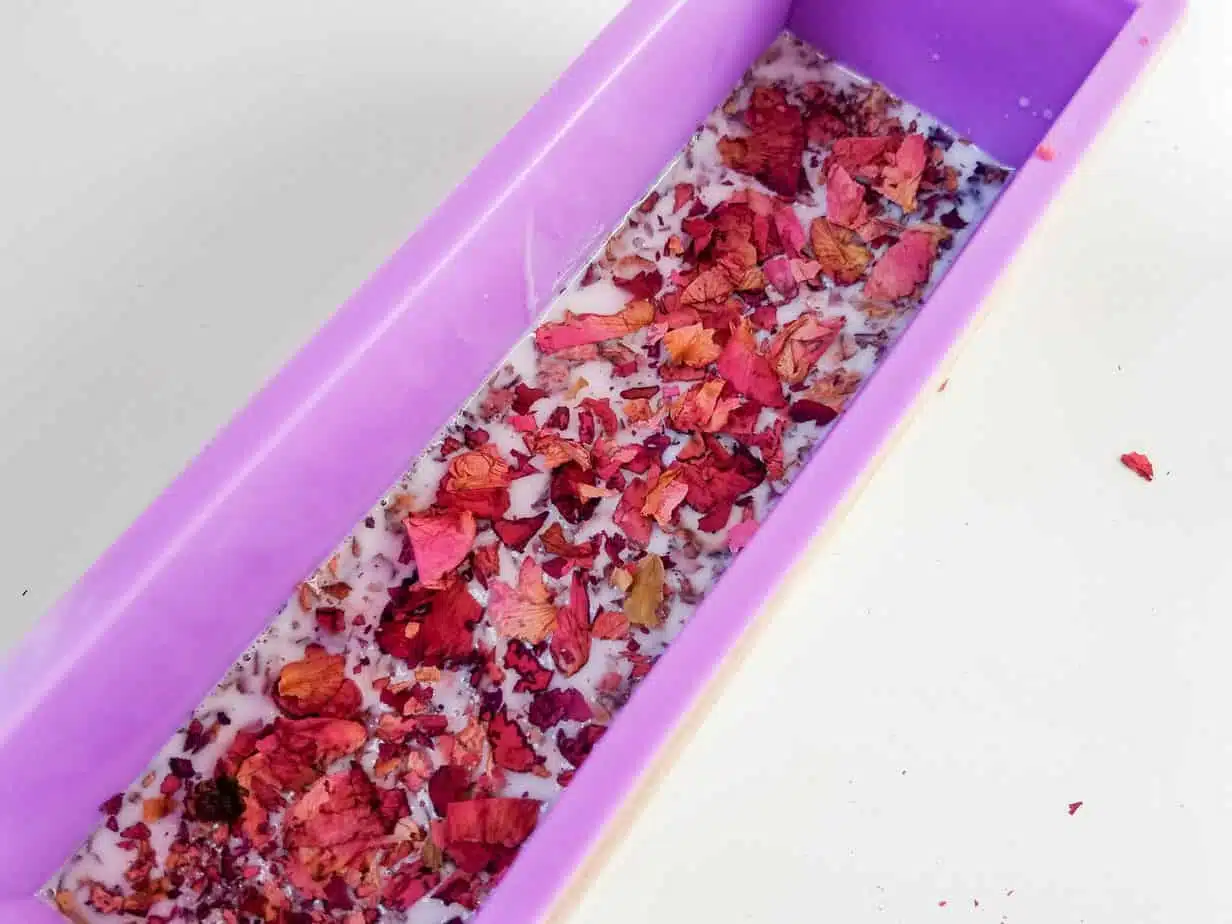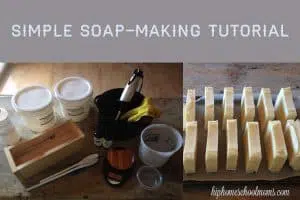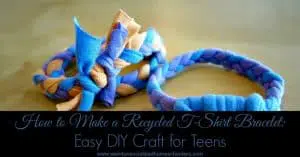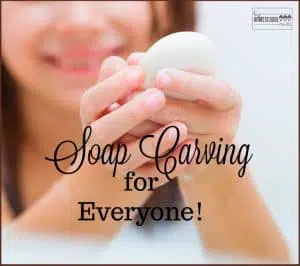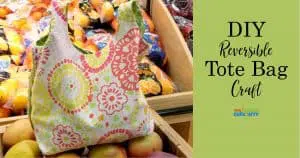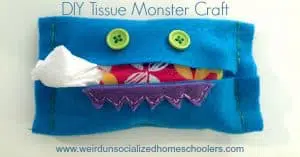Lessons Learned from Making Homemade Soap (and a Recipe for You to Try!)
Homeschooling gives us the freedom to pursue our children’s interests and talents. This means we get to do just plain fun hands-on creative projects like soap making and candle making, sewing, quilting, cross-stitch, and more. You’d be surprised how much you can learn by making handicrafts like these!
Teaching and learning handicrafts were commonly practiced by many homeschool families in the past, but it has become less common in recent years. I hope this article inspires you to keep the tradition alive in your own homeschool family or to create a new tradition if it’s something you’ve never done!
Written by Sara of Heart and Soul Homeschooling.
Lessons Learned from Making Homemade Soap
Soap making happens to be a favorite activity that my daughters and I enjoy. Just from making soap, you can teach your children so many things!
History
- The history of soap:
- When was it first used?
- How was it invented?
- What was it used for?
- The history of soap making:
- What methods were used to make soap in the past?
- How have those methods changed and improved?
- What are some of the differences in the soap-making process when comparing mass-produced soap and homemade soap?
Science
- the chemical changes that happen when ingredients are combined to make soap
- how soap kills germs
- the importance of handwashing
- the differences between natural ingredients and chemicals/artificial ingredients
- Experiment with the buoyancy of soap and what causes its buoyancy.
- physical properties of soap bubbles
- You might even want to have some fun with your own Unpoppable Bubble Recipe! (Included in that article is a short explanation of what bubbles actually are. Look in the “What is a bubble?” section.)
Math
- Have your children practice measuring ingredients in different ways. For example, you could show them how 1/2 cup twice is the same as 1 cup, and that is also the same as 1/4 cup four times!
- Let them practice weighing ingredients. Some soap recipes call for you to weigh rather than measure ingredients. Talk about why that might be the case.
- Figure the cost of making soap versus buying soap. Be sure to note that the cost will vary depending on what kind of soap you make/what recipe you follow since different ingredients cost different amounts.
Entrepreneurship
- Your children may want to consider starting a soap-making business!
- Even if your children don’t actually want to start a soap-making business, they may benefit from doing the planning. This could serve as a lesson in economics and goal setting as well as give them a taste of entrepreneurship in case they decide to give it a try later.
Life Skills
- Soap making is a handy life skill to possess, and it’s one your children will be able to use their whole lives. Wendy, one of the owners of Weird, Unsocialized Homeschoolers, has a daughter who has very sensitive skin and can’t use most soaps, so Wendy has to make soap for her daughter in order to avoid problems with allergies. In other words, you just never know when soap making might come in handy or even prove to be necessary!
- Kitchen skills are important life skills too. Soap making gives your children the chance to practice using the kitchen under your supervision.
Family Bonding/Discussions
- Soap making is something the whole family can do together! As you work together, take opportunities to build relationships and have great conversations. Isn’t that one of the best parts of homeschooling?
Gift Giving
- Homemade soap makes a wonderful gift for Mother’s Day, birthdays, Christmas, you name it! Your children will learn that handmade gifts are special and unique and will appreciate the fact that gifts don’t have to be fancy or expensive to be appreciated.
Soap Making Unit Study
You can use the ideas, information, and links above to do an entire unit study around soap making if you want to! Don’t feel that you must, though. It’s also fine to simply enjoy soap making with your children as an activity on its own. It’s perfectly fine to enjoy activities and hobbies without turning them all into lessons! After all, our children learn so much just by doing hands-on activities like this that it’s not always necessary to create a formal lesson plan. It’s still a good idea, though, to be ready to answer questions or research information if they ask.
Coconut Rose Soap
This coconut rose soap that we recently made reminded us of Victorian times, so we talked about that historical time period. It also prompted some conversations about goat’s milk, roses, and the process of drying flowers. See what I mean? The educational possibilities are just about endless!
Are you ready to give it a try? This simple recipe doesn’t require many ingredients and it’s safe for sensitive skin.
Coconut Rose Homemade Soap Recipe
This recipe makes 5 bars if you use the same mold that we did.
Ingredients/Supplies:
- 1 pound melt & pour goat milk soap base
- dried rose petals (crumbled)
- 10 drops rose fragrance oil
- 10 drops coconut fragrance oil
- silicone soap mold
- rubbing alcohol in a spray bottle
- large Pyrex measuring cup
- wooden stir stick
Directions:
- Cut the soap into 1-inch cubes. Melt the soap in the microwave for 30 seconds. Stir. If it is not completely melted, put it back on for 10-second increments until fully melted, stirring each time.
- Add the rose fragrance.
- Add the coconut fragrance.
- Mix well.
- Add some of the dried rose petals.
- Poor into the silicone mold.
- Stir a bit to evenly distribute the rose petals.
- Top with more dried rose petals.
- Spray lightly with rubbing alcohol to reduce bubbles.
- Let set for about 2-3 hours.
- Remove from mold. Using the wavy scraper that comes with the mold, cut the soap into 2-inch bars.
Don’t get frustrated if your first attempts are a little wonky. It takes some time to get used to using the silicone mold and cutting the bars. Keep in mind that you’ll still end up with a finished product that is usable, even if it doesn’t look exactly even or straight or you have extra slivers left over. Soap doesn’t have to be picture perfect to be useful!
You can experiment with different scents, textures, and ingredients as you become more comfortable with the process. Have fun and use your imagination.
My daughters and I made this particular soap just for fun so we could enjoy some quality mother-daughter time. We had a great time!
Have you ever tried making homemade soap? What hobbies do you include in your homeschool? Let us know in the comments!
You May Also Like:
This soap-making tutorial is for those who are more serious about their soap-making and for those who have older children and teens since it uses lye (which can be very dangerous if not handled properly). We also recommend that you work on this with your children so you can be sure they are working safely.
Encourage Your Kids to Save Money with This Printable Savings Tracker!
Easy DIY Eucalyptus Bath Salts
How to Make a Recycled T-Shirt Bracelet: Easy DIY Craft for Teens
Sara Jordan is a homeschooling mom of three creative girls. They believe in literature-rich learning with living books. Relaxed, delight-directed learning is their approach so they follow interests and explore ideas to encourage a lifelong love of learning. Their emphasis is on nurturing creativity, curiosity, character, and connection. Sara is an author/speaker/consultant who loves to inspire other homeschool moms on her blog, Heart and Soul Homeschooling, and with the resources she creates in the Heart and Soul Homeschooling shop. You can find her on Pinterest, Facebook, and Twitter.



